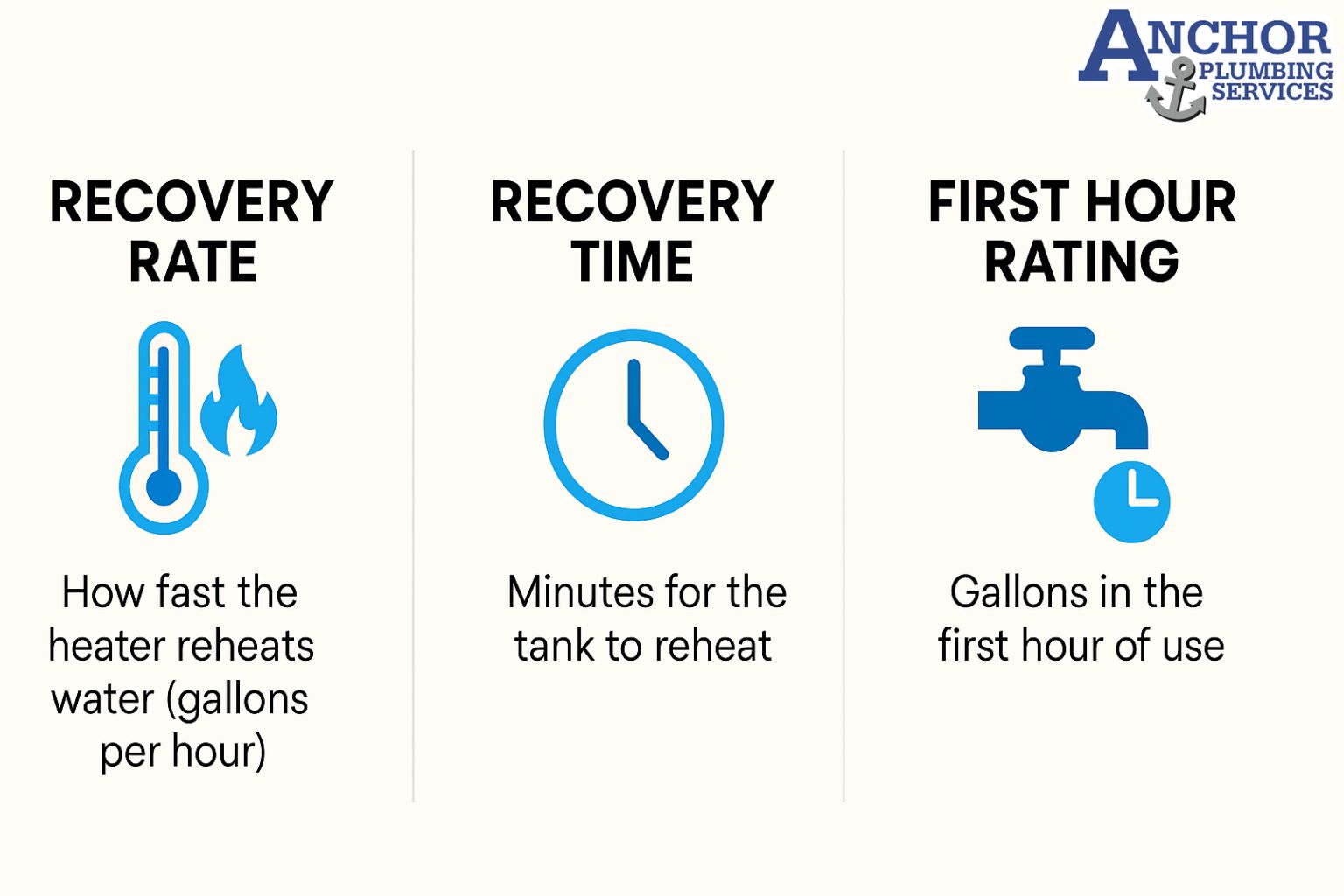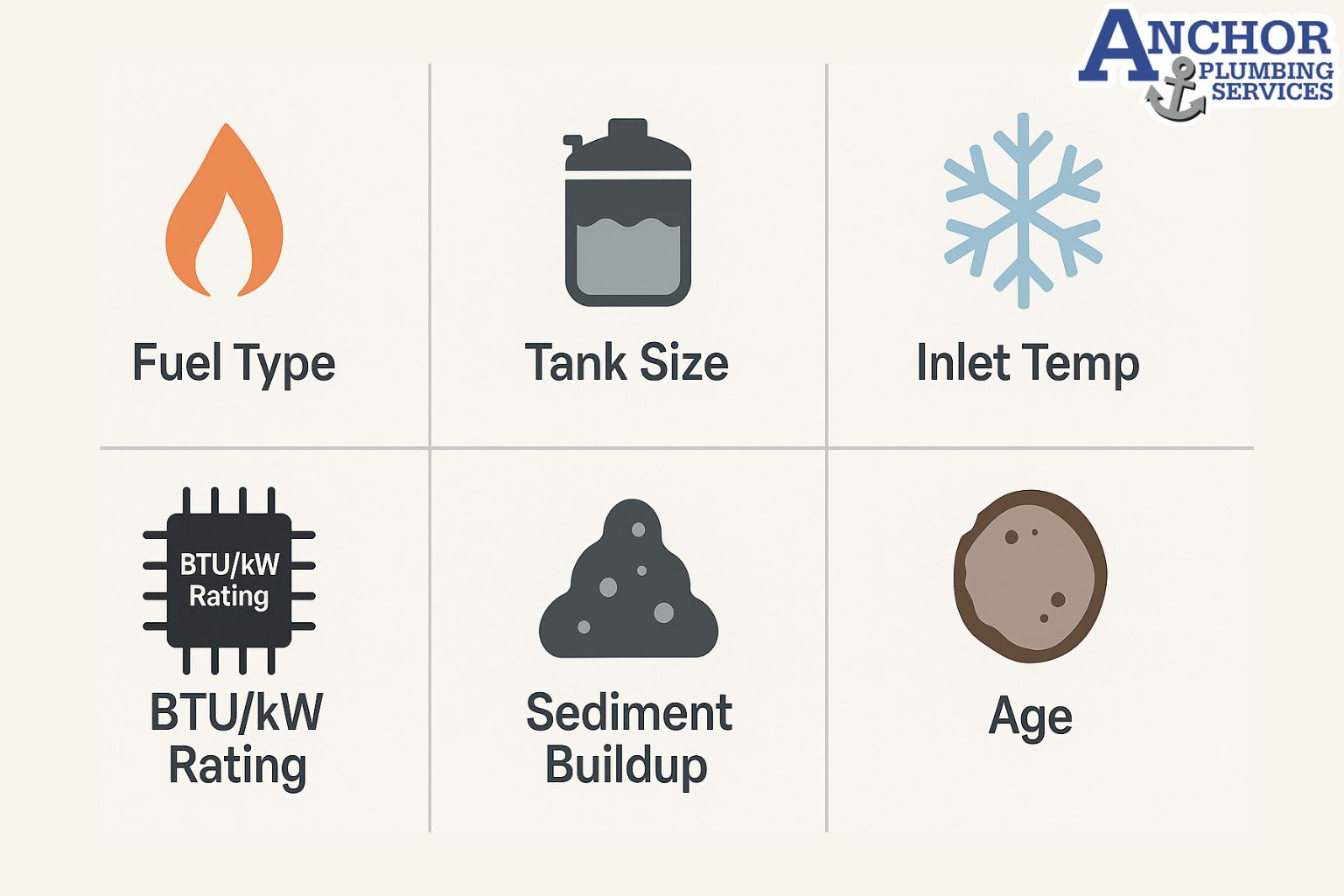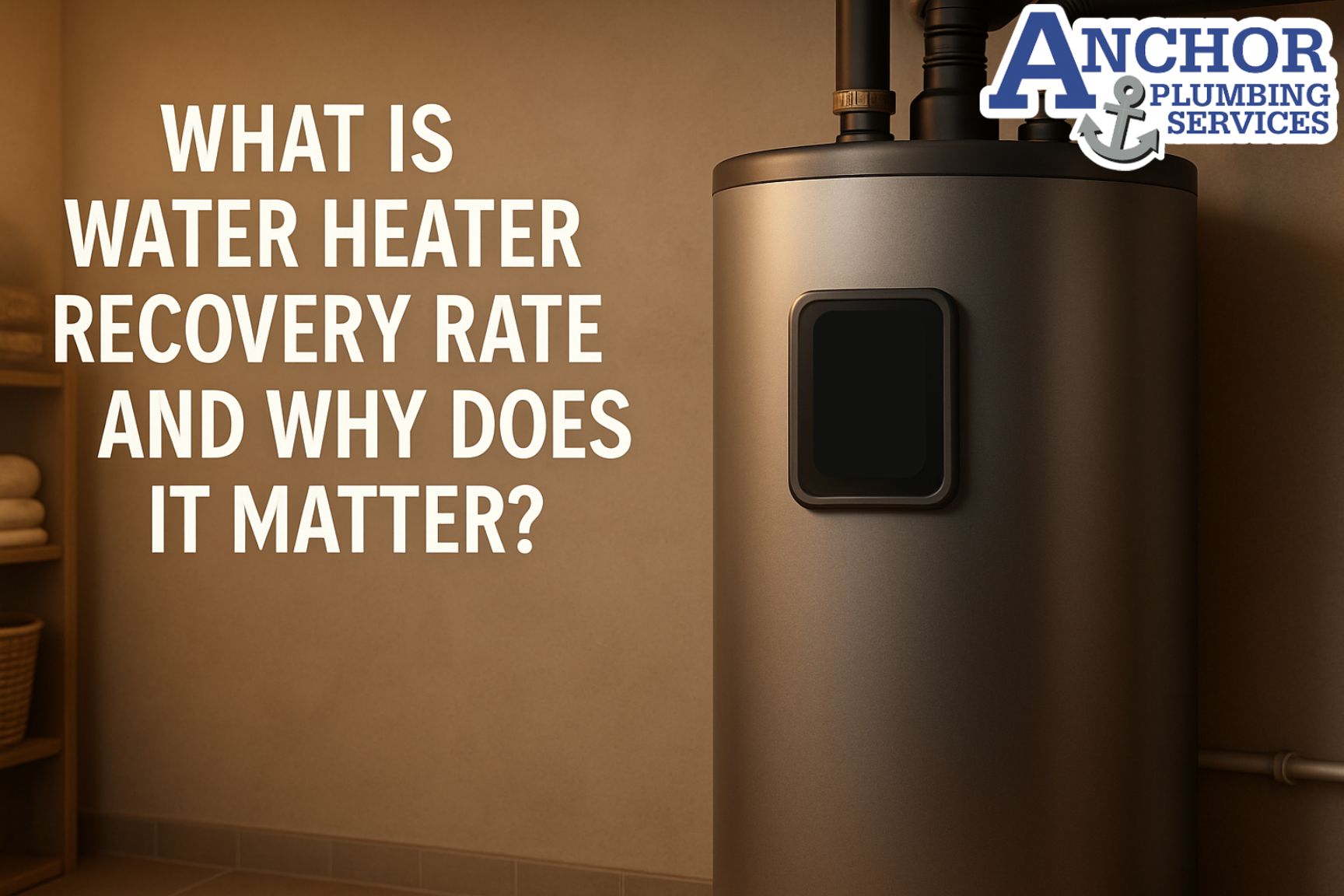Water heater recovery rate is the amount of hot water a tank heats in 1 hour after the stored hot water is used, and hot water recovery time tells you how many minutes you wait for hot water to return. Recovery rate matters because it controls how quickly your water heater keeps up with real life use like back to back showers, laundry cycles, and dishwashing.
On a typical tank water heater, recovery rate is measured in gallons per hour. A gas water heater with a strong burner reheats more gallons per hour than a small electric model with a low kilowatt rating. Tank capacity matters too. A forty gallon tank with a high recovery rate may perform better for a busy family than a larger tank with slow recovery.
Hot water recovery time connects these numbers to daily comfort. It reflects how long you wait for the heater to bring the water from the incoming cold temperature up to your set temperature, often a rise of around ninety degrees. When recovery rate is too low for your household hot water demand, you run out of hot water quickly and wait longer between showers.
Water heater recovery rate is the key number that links fuel type, tank size, and burner or element power to how much usable hot water you actually have each hour.
What Is Water Heater Recovery Rate?
Water heater recovery rate is the number of gallons of water a heater raises from the incoming cold temperature to the set hot temperature in 1 hour after the tank has been drained. In practical terms, recovery rate shows how many gallons of hot water your heater produces each hour once you have used what is already stored in the tank.
Manufacturers list recovery rate as gallons per hour at a specific temperature rise. A typical label might show recovery at a 90 degree temperature rise so you can compare models fairly. Gas heaters use burner input in British thermal units and electric heaters use kilowatt rating to reach that recovery number. Higher BTU or kilowatt input usually means more gallons per hour and a shorter recovery time.
On spec sheets you may see terms such as GPH recovery, BTU input, kilowatt rating, and temperature rise side by side. These values work together. Recovery rate shows how many gallons the heater delivers, BTU or kilowatt input shows how much heating power the unit has, and temperature rise defines how much the heater needs to heat the water above the incoming supply temperature. Understanding these numbers helps you choose a water heater that matches your home’s hot water demand without constant shortages.
What Is Water Heater Recovery Time?
Water heater recovery time is the number of minutes a tank water heater needs to heat a full tank of cold water back to your set temperature. Hot water heater recovery time tells you how long you wait for hot water to return after the tank runs out.
Recovery time depends on tank size and recovery rate. Recovery rate measures gallons reheated per hour, so recovery time equals tank capacity divided by that hourly rate. A forty gallon tank with a strong burner recovers faster than an eighty gallon tank with a slow electric element.
Homeowners care about recovery time because it controls how long the water heater keeps up with real world use. A long shower drains most of the stored hot water and the heater must reheat the entire tank before the next person showers comfortably. Houses with multiple bathrooms or large families need shorter recovery times to avoid long waiting periods.
Recovery time is a practical number that connects tank size, recovery rate, and daily usage patterns. It shows how quickly your home returns to a stable hot water supply after a full draw.
What Are Typical Water Heater Recovery Rates by Fuel Type and Tank Size?
Most gas water heaters recover in 30 to 40 minutes because gas burners deliver more heating power. Electric water heater models usually take 1 to 2 hours because electric elements heat water more slowly. Recovery rate varies by tank size, burner strength, and energy input.
A 40 gallon gas model recovers in 30 minutes. A 50 gallon gas model takes 40 to 50 minutes. An 80 gallon gas model typically takes around 1 hour. Electric models take longer. A 40 gallon electric unit often needs 60 to 90 minutes, and larger tanks need 90 to 120 minutes.
These numbers help match a heater to household size. A 40 gallon gas tank supports 2 to 3 occupants comfortably. A 40 gallon electric tank supports smaller families when recovery time is acceptable. Larger tanks serve homes with multiple bathrooms and higher usage demand.
Typical Recovery Rates and Recovery Times
| Tank Size | Fuel Type | Recovery Rate (GPH) | Approx Recovery Time (minutes) | Occupants Supported |
| 40 gallon | Gas | 40 to 50 GPH | 30 to 40 minutes | 2 to 3 people |
| 40 gallon | Electric | 20 to 25 GPH | 60 to 90 minutes | 1 to 2 people |
| 50 gallon | Gas | 50 to 60 GPH | 40 to 50 minutes | 3 to 4 people |
| 50 gallon | Electric | 20 to 30 GPH | 70 to 100 minutes | 2 to 3 people |
| 80 gallon | Gas | 60 to 70 GPH | 60 to 80 minutes | 4 to 5 people |
| 80 gallon | Electric | 25 to 35 GPH | 90 to 120 minutes | 3 to 4 people |
These ranges give homeowners a clear comparison between gas and electric performance and help them estimate waiting times for hot water.
Recovery Rate vs First Hour Rating: What Is the Difference?

First hour rating measures how many gallons of hot water a tank water heater delivers during the first hour of use when starting with a full tank. Recovery rate measures how fast the heater reheats cold water back to the set temperature after hot water is used. Recovery time is the number of minutes needed for the tank to return to full temperature.
First hour rating reflects real usage conditions. It combines tank capacity and recovery speed to show how many showers or appliance cycles the heater supports within 1 hour. A tank with a 40 gallon capacity and a strong burner delivers 70 to 80 gallons during peak morning use because it reheats water while you draw from the tank.
Recovery rate only measures reheating speed. It does not reflect how much hot water you use at once. A heater with a high recovery rate supports multiple back to back showers because the burner or element replenishes hot water quickly.
Recovery time helps you understand how long you wait for the tank to refill with hot water after a full draw. These three measurements work together to show how a water heater performs during heavy household demand.
What Factors Affect Water Heater Recovery Rate and Recovery Time?

The recovery rate changes when fuel type, burner strength, and tank size vary. These factors directly influence how many gallons the heater reheat each hour and how long it takes to return to full temperature.
- Fuel type: Gas models recover faster because burners deliver higher BTU output. Electric units recover slower because heating elements produce less heat per hour.
- Tank size and shape: Larger tanks store more water and need more time to reheat. Taller tanks have different heat distribution patterns that affect recovery.
- BTU or kilowatt input: Higher input ratings increase recovery rate. A high BTU burner reheats water faster than a low input system.
- Inlet water temperature: Cold winter water forces the heater to work harder. The larger the temperature rises, the longer the recovery time.
- Thermostat setting: Higher set temperatures increase recovery time because the heater must raise the water to a higher final temperature.
- Sediment buildup in the tank: Sediment buildup increases recovery time because it insulates the burner or lower heating element and slows heat transfer into the water.
- Condition of heating elements or burner: Worn heating elements and partially blocked burner ports reduce heat output and lengthen recovery.
- Age of the water heater: Older tanks often lose efficiency due to corrosion, scaling, or declining element performance.
Understanding the above variables helps homeowners evaluate whether their current water heater is performing correctly or showing signs of decline.
What Are the Signs Your Water Heater Recovery Time Is Too Long?
Short bursts of hot water followed by long cold periods mean the recovery time is too slow for the household. Long burner or heating element run times indicate reduced efficiency or declining heat transfer inside the tank.
Common signs include:
- Back to back showers run cold quickly: Short hot water supply suggests a slow recovery rate or weakened heating components.
- Long wait for hot water after a laundry or dishwashing cycle: High demand events drain the tank, and slow reheating indicates poor recovery performance.
- Pilot light or electric heating elements operate longer than normal: Extended heating cycles point to sediment buildup, lower burner output, or failing elements.
- Seasonal increases in heating time compared with previous years: A longer winter recovery time may signal sediment accumulation or age related decline rather than simply cold inlet water.
- Frequent hot water shortages during peak usage periods: Multiple fixtures losing temperature indicates that the tank cannot replenish hot water at the required rate.
These symptoms show the system is struggling to maintain set temperature or deliver steady hot water volume for showers, dishwashers, or washing machines.
How Do You Test Your Water Heater Recovery Time at Home?
Estimate recovery time by running the tank to depletion and measuring how long it takes for hot water to return. A recovery test helps confirm whether the heater is performing within the expected range for its fuel type and tank size.
Follow these steps:
- Check the thermostat setting: Confirm the current temperature setting to establish a baseline for the test.
- Run hot water until the temperature drops significantly: Use a shower or faucet to draw hot water until the supply becomes noticeably cold.
- Shut off the hot water and start a timer: This marks the beginning of the recovery period.
- Wait a standard interval such as 30 or 45 minutes: This allows the burner or heating elements to reheat a portion of the tank.
- Test the hot water at the same faucet: Assess whether the water has returned to an acceptable temperature. A thermometer provides more precise measurement, but it is optional.
- Compare the result to typical expectations: Gas heaters usually regain significant temperature within thirty to sixty minutes. Electric heaters may require sixty to one hundred twenty minutes.
This simple test reveals whether the recovery time aligns with manufacturer performance or signals developing issues inside the tank.
How Do You Improve Water Heater Recovery Rate and Recovery Time?
Flushing the tank restores heat transfer and reduces recovery time by removing sediment that blocks heat movement. Improving fuel input, cleaning heating components, and adjusting system settings also help shorten recovery time and raise recovery rate.
Effective improvements include:
- Flush the tank to remove sediment: Sediment buildup slows heat transfer and extends recovery time. A full tank flush lowers sediment level and restores efficient heating.
- Inspect and replace worn heating elements or clean the gas burner: Electric elements lose output with age. Gas burners lose efficiency when ports collect debris. Restoring full fuel input improves recovery rate.
- Check and adjust the thermostat setting safely: Incorrect thermostat settings increase recovery time. Verifying the temperature set point helps maintain consistent output.
- Verify gas pressure or electrical supply: A gas valve with low pressure or an electrical circuit with limited power reduces heating capacity and extends recovery time.
- Upgrade to a higher BTU gas model or larger tank: Higher BTU input increases recovery rate. A larger tank provides more initial hot water for high demand households.
- Evaluate tankless or hybrid heat pump systems: Tankless models provide continuous hot water without waiting for recovery. Hybrid heat pump systems offer higher efficiency and faster reheating for large families.
These improvements address the key attributes that influence performance, including sediment level, fuel input, efficiency rating, and overall tank capacity.
When Should You Repair vs Replace a Slow Water Heater?
Repair makes sense when the slow recovery time results from a specific fixable component. Replacement becomes the better option when age, corrosion, or repeated recovery failures show the system has reached end of life.
Repair Friendly Conditions:
You usually repair the water heater when:
- The unit is younger than about eight years: Younger systems typically have better structural integrity and available replacement parts.
- A single heating element or gas burner is dirty or worn: Restoring one component often returns normal recovery performance.
- There is no tank corrosion, rust, or leak: A healthy tank structure supports long term repair value.
- Recovery time has increased recently but the unit worked normally before: Recent changes suggest a correctable issue such as sediment buildup or a failing thermostat.
Replacement Signals:
Replacement becomes the better option when:
- The unit is ten to twelve years or older: Older tanks have declining efficiency and higher failure risk.
- Tank rust, leaks, or discolored hot water appear: These symptoms indicate internal corrosion and loss of structural integrity.
- Recovery problems continue after multiple repair attempts: Persistent slow recovery suggests deeper deterioration.
- The tank size is too small for household demand: Low recovery performance often reflects inadequate capacity in multi bathroom homes.
These factors highlight the attributes that influence long term cost, including repair frequency, operating cost, efficiency loss, and structural condition of the tank.
What is a good water heater recovery rate?
A good recovery rate provides thirty to fifty gallons per hour for gas units and twenty to twenty five gallons per hour for electric models. A strong recovery rate supports consistent hot water during back to back showers and high demand use.
How long should hot water heater recovery time be?
Typical recovery time ranges from thirty to sixty minutes for gas systems and sixty to one hundred twenty minutes for electric systems. Recovery time increases when tank size is larger or fuel input is lower.
Why is my water heater recovery time getting longer?
Recovery time increases when sediment collects at the bottom of the tank or when heating elements or the burner lose output. Longer recovery time often indicates maintenance needs or early component failure.
Do gas water heaters have faster recovery rates than electric water heaters?
Gas water heaters recover faster because they deliver higher BTU input. Electric units reheat more slowly due to lower kilowatt output. This difference affects gallons per hour and total recovery time.
How does tank size affect hot water recovery rate?
A larger tank takes longer to reheat because the system must raise temperature across more stored water. Smaller tanks recover faster but may run out of hot water sooner during heavy use.
Does sediment buildup slow water heater recovery time?
Sediment buildup slows recovery time by blocking heat transfer at the bottom of the tank. Heavy sediment forces the burner or heating elements to run longer to reach a set temperature.
How should I flush my water heater to maintain recovery rate?
A water heater should be flushed once a year to remove sediment and maintain normal recovery rate. Homes with very hard water benefit from flushing twice a year to protect the tank.
Conclusion
Understanding recovery rate and recovery time helps you size and maintain your water heater correctly. Faster recovery supports consistent hot water for showers, laundry, and dishwashing. Slow recovery often signals sediment buildup, worn heating components, or a tank that no longer meets household demand.
A timely inspection prevents rising utility bills, repeated shortages, and early system failure. Anchor Plumbing Services provides professional diagnostics, recovery rate improvements, and full water heater replacement across San Antonio. Our licensed plumbers restore reliable hot water with precise testing and clear upfront pricing.


